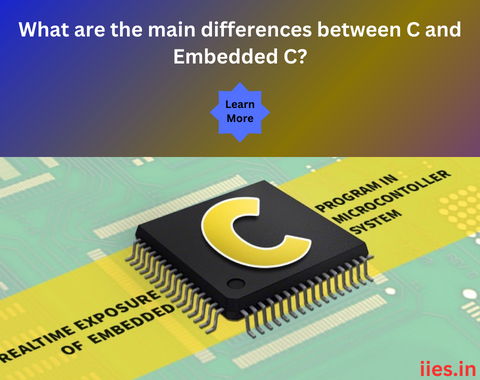
C programming language has long been a stalwart in the realm of software development, serving as the foundation for countless applications across various domains. As technology advances, specialized areas such as embedded systems demand tailored programming approaches to address unique challenges. Embedded C, a variant of the traditional C language, has emerged as a key player in the development of embedded systems. In this article, we will delve into a comprehensive comparison of C and Embedded C, exploring their similarities, differences, and the specific scenarios in which each excels.
C, often referred to as the “mother of all programming languages,” was developed by Dennis Ritchie at Bell Labs in the early 1970s. It is a general-purpose programming language known for its efficiency, portability, and low-level programming capabilities. C has found applications in various fields, including system programming, game development, and desktop applications
1. Portability:
– C code is highly portable, meaning it can be compiled and executed on different platforms with minimal modifications.
2. Efficiency:
– C allows low-level manipulation of memory, enabling developers to write efficient and optimized code. It provides direct access to hardware, which is crucial for performance-critical applications.
3. Procedural Programming:
This makes code organization and maintenance relatively straightforward.
Embedded C is a variant of the C programming language tailored for embedded systems, which are specialized computing systems embedded within larger devices. These systems range from consumer electronics like washing machines to complex machinery in industrial applications. Embedded C incorporates features to address the constraints and requirements of embedded systems.
1. Limited Resources:
– Embedded systems often operate with limited resources such as memory and processing power. Embedded C is designed to optimize resource usage, ensuring efficient execution in resource-constrained environments.
2. Real-time Operation:
– Many embedded systems require real-time operation, meaning they must respond to events within a specific time frame. Embedded C facilitates the development of real-time applications by providing mechanisms for precise timing control.
3. Peripheral Access:
– Embedded C allows direct access to hardware peripherals, enabling developers to interact with sensors, actuators, and other hardware components efficiently. This is crucial for embedded systems, where direct hardware control is often necessary.
1. Memory Management:
– In traditional C, developers have more flexibility in memory management, which can be a double-edged sword. While it allows for fine-tuning and optimization, it also opens the door to potential memory-related issues. Embedded C, on the other hand, often employs stricter memory management to accommodate the limited resources of embedded systems, reducing the likelihood of memory-related errors.
2. Functionality and Abstraction:
– C is a versatile language with a broad range of applications. It supports high-level abstractions and is suitable for applications where a high degree of functionality is required. Embedded C, however, tends to focus on low-level hardware interactions and sacrifices some high-level abstractions to optimize for resource efficiency.
3. Portability:
– While both C and Embedded C are portable to some extent, the level of portability may differ. Traditional C code, being more generic, can be easily ported across different platforms. Embedded C, due to its specialized nature, may require more adjustments when moving between different embedded systems with varying architectures.
4. Development Environment:
– C development environments are widely available and well-established. Developers working with C can leverage a plethora of tools and libraries for diverse applications. Embedded C, on the other hand, may require specialized development environments and tools tailored to the target embedded system.
5. Real-time Capabilities:
– Embedded C is often preferred in real-time applications where precise timing control is essential. It provides features like interrupt handling and scheduling mechanisms that enable developers to meet stringent real-time requirements. While C can also handle real-time tasks, it may require additional considerations and libraries.
The C programming language has a vast and mature community, with decades of collective knowledge and resources available. Developers working with C can benefit from extensive documentation, forums, and libraries. Embedded C, while also supported by a dedicated community, may not have the same breadth of resources, as it caters to a more specialized niche. However, the embedded systems community is active, sharing insights and solutions tailored to the unique challenges faced in this domain.
Safety and Security:
Both C and Embedded C can be used to write secure and robust code. However, C’s flexibility in memory management can potentially lead to vulnerabilities such as buffer overflows and memory leaks if not handled carefully. Embedded C, with its emphasis on resource efficiency, often encourages practices that enhance code safety, making it less prone to certain types of vulnerabilities. Nevertheless, developers in both domains must adhere to best practices to ensure the security of their applications.
Scalability:
When it comes to scalability, C has proven its worth in large-scale software projects. Its modular and structured nature allows for the development of complex systems with multiple contributors. Embedded C, while scalable for embedded applications, may face challenges when dealing with large-scale, distributed systems that require extensive coordination and communication between components.
In conclusion, both C and Embedded C have their places in the vast landscape of programming languages, each tailored to specific needs and challenges. Traditional C remains a powerhouse for general-purpose programming, providing a robust foundation for a wide range of applications. On the other hand, Embedded C shines in the realm of embedded systems, offering optimizations for resource-constrained environments and facilitating direct hardware interactions.
The choice between C and Embedded C depends on the nature of the project, its requirements, and the specific constraints faced by the developer. As technology continues to advance, the versatility of C and the specialization of Embedded C will ensure their relevance in the ever-evolving world of software development.
Indian Institute of Embedded Systems – IIES